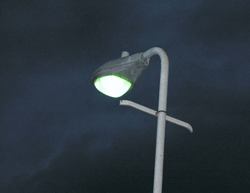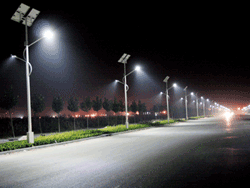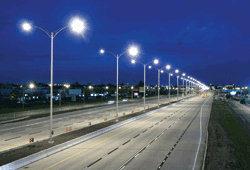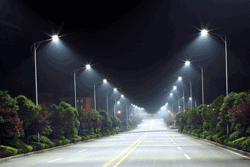Both offer tremendous upside, and it’s only a matter of time before we begin to see widespread adoption
Energy-efficient streetlights are fast becoming a popular topic of conversation among communities. Deservedly so — it’s a worthwhile, cost-saving solution to today’s standard streetlights. It offers reduced sized, requires less energy, and is capable of providing better brightness. This all adds up to greater efficiency and considerable savings.
Energy-efficient streetlights integrate modern-day “green” lamp technologies with strategic pole placement and enhanced fixture photometrics, to meet performance, aesthetic, and energy demands. In order to fully understand how these technological solutions are better, it’s important to first review the current systems in place. Two examples of modern-day street-lighting technologies include the mercury-vapor lamp and sodium-vapor lamp.
Mercury-vapor lamp

(Credit: lighting-gallery.net)
This is a gas discharge lamp that uses mercury in an excited state to produce light. Its arc discharge is typically confined to a small fused quartz arc tube mounted within a larger borosilicate glass bulb. The outer bulb is either clear or coated with a phosphor, and its purpose is to provide thermal insulation, protect from ultraviolet radiation, and allow for the mounting of the fused quartz arc tube. Phosphor coated bulbs, in particular, are considered to offer terrific color rendition. These lamps are well-regarded because they’re durable and last a long time.
When they start to deter, though, is when the headaches begin with this light. That’s because they don’t ever really burn out; rather, they go through a sort of lumen depreciation. The lamp produces nearly half the light it was producing every five years, to the point where it eventually just becomes ineffective.
As if that’s not frustrating enough, while it’s going through this reduction-in-production, it’s still drawing the same amount of power. That’s right — this lamp can be producing a smidgen of light, yet it still draws the same amount of power as if it were brand new.
Sodium-vapor lamp

(Credit: news.cnet.com)
Also a gas discharge lamp, this particular fixture uses sodium in an excited state to produce light. There are two types of this lamp: low-pressure and high-pressure.
Low-pressure sodium-vapor lamps: preferred where light pollution is an important consideration. They emit light on just one dominant spectral line (with several other weaker lines). This makes them easier to filter out.
High-pressure sodium-vapor lamps: smaller than low-pressure lamps, they contain additional elements like mercury, and produce a dark pink glow when first turned on, and a pinkish sort-of orange light when warmed up.
The light output of a sodium-vapor lamp is produced at a wavelength near the peak sensitivity of the human eye. They emit a soft luminous glow (less glare) and do not decline in lumen output with age (unlike some other streetlights we know about). They’re considered efficient because their energy usage increases slightly (approximately 10%) toward the end of their life, and they last about 18,000 hours.
So, if this light works so well, why look for an alternative?
Well, it was recently discovered that whiter light can provide better results at lower wattages than what it takes to run these lamps. Sure, sodium-vapor lamps get turned on at a relatively low voltage, but they heat up during operation. As this happens, the internal gas pressure within the arc tube rises. This results in more voltage being required to maintain the light’s arc discharge. When the light is old, the arc tends to fail at this point, and the lamp goes out. With the arc out, the lamp gets a chance to cool down. This allows for it to reduce gas pressure. Once everything’s back to their optimal state, the ballast again causes the arc to strike, and this process is repeated. This is what causes the common effect one sees with a streetlight turning on/off repeatedly.
Energy efficient alternatives
There are plenty of alternatives to choose from, but two of the more popular solutions that seem to be getting all the buzz lately are solar-power and control lighting.
Solar-power

(Credit: solar-street-lighting.com)
Solar power streetlights provide an intense, uniform distribution of light by using precision optics to direct light in exact, repeatable patterns. This, in turn, helps maximize their pole spacing.
Solar power streetlights can be quickly and easily deployed. Given that they run on an independent power source (the sun), they can be placed outside local power grids. They don’t require relamping or reballasting, and direct line wiring is used instead of starters or capacitors. Such efficiency saves communities thousands of dollars in maintenance over its 60,000-plus-hour lifespan.
These lamps consist of four key elements:
1. Solar panel : converts the sun’s energy into electricity. Different size panels and power outputs are available, but they need to be chosen based on the specific application, with particular consideration being paid to weather conditions.
2. Solar controller : basic circuitry of the lamp, it consists of an automatic battery charger (to protect the batter from too-low or over-charge), and a lighting controller that is automated for dusk to dawn operation.
3. Battery : provides energy for dusk to dawn operation. It must also be able to supply a few days of backup power in case of bad weather or charger failure.
4. Lamp : choice of lamp depends upon how the solar power streetlight is being used, but there are basically three to choose from:
a. Light emitting diodes (LED): offer excellent color rendition. They consume very little energy and have a long life span. Solar power LED streetlights are emerging as perhaps the most promising application for this particular technology.
b. Compact fluorescent (CF): produces a very white light, and often get used in places where color rendering is desired.
c. High Intensity Discharge (HID): either of the low-pressure sodium (LPS) or metal halide (MH) variety. The LPS generates a monochromatic yellow-orange light and is used when color rendering is not an issue. MH lamps, on the other hand, are similar to CF lamps in that they produce a clean white light and are good for applications where color rendering is important.
There are plenty of obvious benefits to using solar-powered streetlights. For one, daily operation and maintenance costs are reduced. Also, lack of wiring means installation is quick and easy and does not disrupt, say, traffic. Power outages have no impact on these lights and there’s no harmful CO2 emission, which makes it great for the environment.
Control lighting

This technology uses a low-cost, low-power wireless sensor to allow controllers to turn lights on/off on a set schedule, and dim or raise the lighting based on conditions outside, all from a remote location.
An example of dimming capabilities is ZigBee technology. A ZigBee device is connected to or embedded inside an LED light. It receives the wireless signal from a master control device that allows it to adjust the light to a desired setting. Through ZigBee, dimming can be done on command, automatically, or dynamically with a preloaded program. Specifically, by dimming the light, you are reducing energy draw. This greater level of control helps significantly reduce the costs of running/maintaining the light.
Furthermore, ZigBee can automatically detect when a streetlight has burnt out and needs to be replaced. This saves time and money when compared to having a city employee travel up and down every block or highway to check the status of the streetlights. This has its safety benefits, too, as the light can be replaced quickly, rather than waiting for the next community-wide inspection.
LEDs in streetlights

(Credit: commsunlight.com)
Both examples suggest LEDs as being the ideal light to use when looking at the future of streetlighting. That’s because LEDs deliver a host of benefits, including a smaller size lighting element, increased brightness, reduced energy usage, better durability, lower total cost, and greater versatility. LEDs don’t take time to warm up, and they don’t require the use of hazardous materials.
One of the biggest issues holding back the widespread adoption of LEDs is price. But even with this consideration, the reduced cost of electricity and maintenance ends up, in most cases, offsetting the cost of the lamp. ■
Advertisement
Learn more about Electronic Products Magazine





